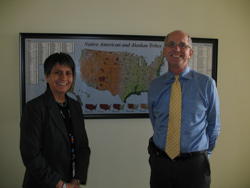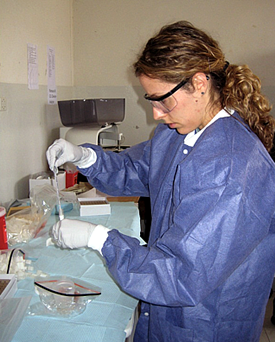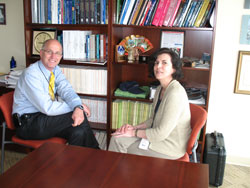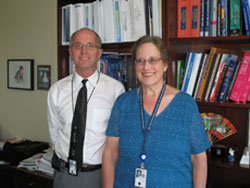Categories: Emergency Preparedness, Environmental Hazards and Health Effects, National Center for Environmental Health
February 5th, 2013 12:59 pm ET -

Although some parts of the country are warming up already, winter is not “officially” over until March 20. So stay ready for winter hazards. You will be more likely to remain safe and healthy if you are prepared.
Indoor Safety
You may prefer to remain indoors in the winter as much as possible, but staying inside is no guarantee of safety. Take these steps to keep your home safe and warm even if you lose power.
 Post a Comment -
Read more
Post a Comment -
Read more

Categories: National Center for Environmental Health, Sharing Our Stories
January 29th, 2013 11:24 am ET -

In April 2004, illness and death plagued rural Kenya. No one knew what the source could be. At the core of this mystery, however, was an outbreak— jaundice with a high rate of fatality in the districts of Makueni and Kitui, Eastern Province. Officials were at a loss for answers. Stumped, they were catapulted into a mission to discover the cause of the illness.
The Kenya Ministry of Health (MOH) invited several organizations and agencies to participate in the outbreak investigation including CDC Kenya and CDC’s National Center for Environmental Health (NCEH)
(Health Studies Branch HSB)
 Post a Comment -
Read more
Post a Comment -
Read more

Categories: National Center for Environmental Health
January 16th, 2013 12:37 pm ET -
NCEH and ATSDR post this blog in honor of the Martin Luther King, Jr. Day of Service, January 21, 2013.

An industrial plant, a truck depot, a hazardous waste site, a garbage dump—would you mind having one of these in your neighborhood? Of course you would! No one wants to live with dirty air or water, constant noise and traffic, or sickening smells. But many communities have lived with these unhealthy conditions for years.
In fact, studies have shown that those who live, work, and play in America’s most polluted environments are commonly minority and low income populations. In addition, these groups often have inadequate access to transportation, housing, medical care, public health, jobs, healthy food sources, and schools.
 Post a Comment -
Read more
Post a Comment -
Read more

Categories: Biomonitoring, National Center for Environmental Health, Sharing Our Stories
January 9th, 2013 9:25 am ET -
Dr. Christopher J. Portier
January 6-12, 2013 is National Folic Acid Awareness Week. The following blog post explains the importance of folic acid in the diet of a pregnant woman and her unborn child and the significance of folic acid research and biomonitoring by NCEH’s Environmental Health Laboratory.
A couple of decades ago, about 4,000 babies were born each year with neural tube defects, which are major birth defects of a baby’s brain or spine that can cause severe disability or death. These defects occur during early pregnancy, often before a woman knows she is pregnant. For example, spina bifida is one type of neural tube defect and may cause physical and mental disabilities that range from mild to severe. CDC has played a major role in changes that dramatically decreased the number of babies born with neural tube defects.
Did you Know…
In 1992, the U.S. Public Health Service recommended that all women of childbearing age capable of becoming pregnant consume 400 micrograms (mcg) of folic acid daily to prevent neural tube defects. Research has shown that a woman’s intake of folic acid prior to conception and throughout the first few weeks of pregnancy can prevent many neural tube defects.
Environmental Health Lab Detects Low Folate Levels

Watch a video to hear individuals with spina bifida and their parents talk about living with neural tube defects.
Folate is a type of B vitamin known to be especially important when cells rapidly divide and grow during pregnancy and infancy. Folate occurs naturally in leafy green vegetables, fruits, and dried beans and peas. Folic acid is the synthetic form of folate used in supplements and added to fortify foods.
In the mid 1990’s, NCEH’s Environmental Health Laboratory used blood samples collected by the National Health and Nutrition Examination Survey (NHANES) to measure folate levels in the U.S. population. CDC found that folate levels were particularly low in women of childbearing age. CDC scientists were concerned because they knew that low folate levels were linked to neural tube defects.
 1 Comment -
Read more
1 Comment -
Read more

Categories: Agency for Toxic Substances and Disease Registry (ATSDR)
January 3rd, 2013 9:51 am ET -
For more than 100 years, the American Brass Company operated a brass and copper foundry in the center of Kenosha, Wisconsin. When the factory closed in 2000, a wasteland of contaminants was left behind. Kenosha city officials knew about the closing and had their eyes on the land—a sprawling 29 acres—for redevelopment even before the factory officially closed.
In 1996, city officials had started discussing redevelopment plans with the community. But the soil on the site was contaminated with polychlorinated biphenyls, metals, oil, volatile organic compounds, and polycyclic aromatic hydrocarbons.

Think of a brownfield site as land that has a past. The sites once were home to industrial plants, gas stations, dumps, and other industrial activities that may have contaminated them. These urban sites, however, can be redeveloped in ways that help the environment and the community.
When Kenosha acquired ownership of the American Brass Company site, they engaged with developmental contractor TRC. In 2004, TRC asked the Wisconsin Department of Health Services (WDHS) for help in remediating and redeveloping the site.
 Post a Comment -
Read more
Post a Comment -
Read more

Categories: Agency for Toxic Substances and Disease Registry (ATSDR), From the Director, Meet the Scientist Blog Series
December 20th, 2012 9:49 am ET -

Dr. Portier meets with Annabelle Allison
My “Meet the Scientist” series brings you conversations with NCEH/ATSDR scientists. These conversations aim to give you a sense of the talented people who are working to keep you safe and secure from things in the environment that threaten our nation’s health.
Meet Annabelle
NCEH/ATSDR Tribal Affairs Liaison and Hatch green chili fan Annabelle Allison was born and raised in New Mexico. “I’m a member of the Navajo tribe. My mother’s clan is Honághááhnii, which means ‘One Walks Around You.’ My father’s is Tó dích’íinii or the ‘Bitter Water Clan.’ I grew up on the Navajo reservation in a small community called Tohatchi, New Mexico. I left the reservation when I graduated high school and attended San Juan College in Farmington, New Mexico to study biomedical sciences.”
 Post a Comment -
Read more
Post a Comment -
Read more

Categories: National Center for Environmental Health, Sharing Our Stories
October 30th, 2012 2:33 pm ET -

Danielle Buttke processes samples.
Mystery Illness in Ethiopia
A strange new illness was spreading throughout Tigray, the northern region of Ethiopia. People living in remote homes and villages developed swollen, painful abdomens and then lost weight. Some of them had trouble breathing as the fluid in their abdomens crowded their lungs.
Three or four family members in one household might become ill, while others living in the same household did not. In some families, everyone died from the disease. Even children as young as 5 years old became too weak to move, their abdomens swollen with up to four liters of fluid. People were sick, even dying, from an illness that demonstrated symptoms commonly seen in liver disease. But what was causing it?
 Post a Comment -
Read more
Post a Comment -
Read more

Categories: Agency for Toxic Substances and Disease Registry (ATSDR), From the Director, Meet the Scientist Blog Series
October 9th, 2012 8:20 am ET -

Dr. Portier meets with Jona Ogden
My “Meet the Scientist” series brings you conversations with NCEH/ATSDR scientists that aim to give you a sense of the talented people who are working to keep you safe and secure from those things in the environment that threaten our nation’s health. Graduate student, homeless shelter volunteer, hand-washing expert, and rock-climber-in-training, meet Jona Ogden, one of ATSDR’s newest Health Scientists.
About Jona
Jona was born in Newport News, Virginia, but her family moved to Augusta, Georgia where she lived for most of her life. She graduated from the University of Georgia. Although her initial plan was to become a pharmacist, Jona found she wanted more interaction with people,
 2 Comments -
Read more
2 Comments -
Read more

Categories: Agency for Toxic Substances and Disease Registry (ATSDR), From the Director, Meet the Scientist Blog Series
September 21st, 2012 1:29 pm ET -

Dr. Portier meets with Dr. Antonia Calafat
My “Meet the Scientist” series brings you conversations with NCEH/ATSDR scientists that aim to give you a sense of the talented people who are working to keep you safe and secure from things in the environment that threaten our nation’s health. A native of Majorca, Spain, Fulbright scholar, and accomplished researcher and author, meet my next interviewee, Dr. Antonia Calafat.
About Antonia
Antonia Calafat, PhD, is a Distinguished Consultant in the NCEH’s Division of Laboratory Sciences (DLS). Born and raised in Majorca, Spain, she received a degree in chemistry from the University of the Balearic Islands. “Why chemistry?” I asked. “The university had a rather limited science curriculum, and I was originally undecided between chemistry, biology, and pharmacy. I did not like botany very much, and I soon discovered my love of the chemical elements. Add to that my desire to work in a lab and conduct research, I decided I’d much rather study chemistry,” she replied.
 Post a Comment -
Read more
Post a Comment -
Read more

Categories: Agency for Toxic Substances and Disease Registry (ATSDR), From the Director, Meet the Scientist Blog Series
August 20th, 2012 2:09 pm ET -

Dr. Portier meets with Sue Casteel
My “Meet the Scientist” series brings you conversations with NCEH/ATSDR scientists that aim to give you a sense of the talented people who are working to keep you safe and secure from things in the environment that threaten our nation’s health. I chatted with someone who knows the Clintons (yes, Bill and Hilary), and is a scuba diver and basket weaver, though not at the same time! Meet ATSDR regional representative Sue Casteel.
Sue is originally from the small town of Calico Rock, Arkansas. She completed her undergraduate studies in biology and chemistry at Hendrix College in Arkansas, and she earned her graduate degree in environmental health from the University of Arkansas. And just for the record, she’s a Razorbacks fan.
 Post a Comment -
Read more
Post a Comment -
Read more












